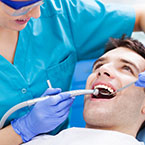How to Stop Tooth Decay

Summary
Table of Contents

This blog has been reviewed and approved by Dr Robert Lee, a dental professional of 35 years
LEARN MORE >Is There a Cure for Tooth Decay?
Year after year, tooth decay is one of the most common diseases that people face. Indeed, tooth decay, also more commonly known as cavities or caries, plagues mouths across the world. Tooth decay happens when plaque, which is the sticky substance that forms on teeth, combines with sugars from the food we eat. This combination produces acids that can damage and weaken tooth enamel. While there is no cure for tooth decay beyond professional dental treatment, there are actions you can take to prevent cavities. Let's get into more detail about tooth decay.
What is Tooth Decay?
Food and bacteria can cause tooth decay (known as cavities). Plaque is always forming inside your mouth. This sticky substance is getting on your gums and your teeth, and it contains the bacteria that feast on the sugars from the food we eat. When bacteria feed, they make acid. And that acid can attack your teeth well after you are done eating, and over a long enough period, they can start to destroy the tooth's enamel (the outermost layer of the tooth). Left untreated, decay will work its way throughout your entire tooth and all of its layers. You may not notice pain or sensitivity until decay goes through your tooth enamel and into the dentin layer, which can become irritated by hot or cold foods and drinks. There are more factors and behaviour's that can make you more likely to get tooth decay. These include a poor oral hygiene routine, high sugar intake, and dry mouth.
What does tooth decay look like? Tooth decay in the early stages is hard to notice. White spots start to appear on the surface of your teeth, which indicates calcium deficit. The next stage of tooth decay is the breakdown of the enamel beneath the tooth’s surface. At this stage, teeth may become hypersensitive to certain type of food. They are also prone to chipping. If the untreated tooth decay advances, it leads to the breakdown of dentin. At this point a cavity filling is required. If you don’t see a dentist during that stage, you take a risk beyond decay. The bacteria could infect the pulp. In this case, a root canal may be necessary to treat the infection and stop the decay. The most serious stage of tooth decay is when tooth abscess occurs. The infection becomes advanced at this stage and there may be a need to extract the tooth.
What Causes Tooth Decay?
First and foremost, not brushing your teeth can be the biggest factor. Tooth decay often occurs on the molar teeth which are usually not as thoroughly brushed compared to the front teeth. In the early stage of molar tooth decay, you might not be able to notice that there is something wrong with your teeth. Therefore, it is crucial for you to pay attention to thorough brushing of your back teeth. Brush your teeth at least twice a day with a fluoride toothpaste and be sure to floss regularly. Book appointments with your dental office for cleanings and check-ups to stay on top of your teeth and stay ahead of cavities.
Another factor of tooth decay is the type of food you eat. If you eat foods that are high in sugar, you are giving the bacteria in your mouth more to feed on. You may have heard it before, but try to avoid candy, soda, juice, and cookies. Limit the number of snacks you consume between meals, as increased consumption of sugary foods can elevate the risk of decay.
Another culprit of tooth decay can be dry mouth syndrome and not having enough saliva in your mouth. Saliva acts as a natural protection for your teeth, buffering the acids produced by plaque and washing away food and the harmful sugars from your mouth. Incorporating fluoride-based toothpaste in your oral care routine can make your teeth more resilient to acids. In addition to toothpaste, several oral rinses or mouthwashes also include fluoride.
How Does A Cavity Happen?
If you often consume sugary drinks or foods, a dental cavity can occur if a tooth is frequently exposed to acid. Over time, acids that continuously attack your teeth may lead to the demineralization of your tooth enamel. Reversible white spots on your teeth mean you have lost some minerals, and that’s a sign you might be heading towards tooth decay. To help strengthen enamel, consider using an enamel-protection toothpaste like Crest Pro-Health Densify Dual Action Daily Protection. The fluoride formula helps rebuild surface tooth density every time you brush to better extend the life of your teeth by remineralizing enamel.
How to Prevent Tooth Decay from Getting Worse
While not curable, you can try to stop tooth decay early with good oral hygiene. This includes brushing with an Oral-B electric toothbrush to help remove more plaque and help prevent cavities from forming in the first place. It’s also important to be aware that enamel is able to repair itself by using saliva’s minerals, and this is greatly assisted by the fluoride sources like toothpaste.
How to stop the development of tooth decay?
- Avoid snacking between your meals – the more frequently you reach for a snack, the more vulnerable to the effects of acids your teeth get. The tooth surface is covered with plaque which damages teeth and can lead to cavities.
- Use toothpastes or products containing fluoride to better protect your tooth’s enamel.
- Brush at least 2X/day for the dentist-recommended 2 minutes and floss at least 1X/day. Supplement regular string floss like Oral-B Glide Deep4 Clean with an oral irrigator like the Oral-B Water Flosser Advanced to further wash away any remaining plaque and food particles that brushing alone can leave behind.
- Keep up with regular visits to your dental professional for professional cleanings and checkups.
For more info or to find out other ways to stop tooth decay read this article on cavity prevention.

How to Treat Tooth Decay
While there is no true tooth decay cure, there are treatment options. Early tooth decay treatment requires the use of products that help restore the structure of the tooth. Your dental professional may apply fluoride on a selected area or secure it with a special dental sealant. The treatment of tooth decay depends on the stage of the disease. A dentist might need to drill to remove the decayed portion of a tooth and use a filling to replace it. If a tooth is in very bad condition, you might need to remove the extensively damaged tooth structure and replace it with a crown, which is fitted around whatever remains of the tooth. If it's so bad that the nerves of a tooth are dead, a root canal treatment might be necessary. That involves removing nerves and tissue along with the decayed tooth and placing a crown on top.
The Basics Are Best
In the fight against cavities, following a good daily oral care regimen is the best course of action. It’s worth noting that decay might be reversible with regular brushing using a fluoridated toothpaste. Enamel can repair itself by using minerals from saliva and fluoride from toothpaste or other sources. A fluoride toothpaste and electric toothbrush are powerful tools for getting the most out of your routine.
- Find the right toothbrush for you. Oral-B Electric Toothbrushes have perfect options for everyone from teens to adults.
- Brush for two minutes, twice a day. Spend at least 30 seconds on each quadrant of your mouth.
- Use fluoride toothpaste and rinse. Fluoride has been proven to enhance dental health.
- Don't forget to floss. Remove food particles and plaque that brushing may miss with Oral-B Glide Deep Clean Floss which uses unique technology to deliver deep cleaning power with the extra comfort you'd expect from Glide.
Want to Do Even More?
A few simple lifestyle adjustments can have big payoffs for your dental health.
- Monitor what you eat. Reducing decay depends on a well-balanced diet. Think twice about high-sugar or heavy-starch diets.
- Get your greens. Dark, leafy fruits and vegetables add calcium and reduce acids in saliva.
- Stay hydrated. A dry mouth allows plaque to be retained in the mouth. Drink plenty of tap water that contains fluoride.
- Watch coffee, soda, and alcohol intake. Ingredients in certain liquids and foods discolor the tooth surface, and too much phosphorus depletes calcium.
- Take supplements. Vitamins C and D help support tooth health. Check with your healthcare provider before taking any supplements.
How Can My Dental Professional Help?
Visit your dental professional for a check-up twice a year. Having a professional cleaning and polishing not only keeps your smile bright, but is also an opportunity to have stubborn plaque and tartar removed. A thorough visual exam will reveal small issues before they develop into bigger ones, and X-rays show potential problems that the naked eye can’t detect. And don’t forget—your dental professional is also a great source of advice on the best oral care products for you.

Table of Contents
- Is There a Cure for Tooth Decay?
- What is Tooth Decay?
- What Causes Tooth Decay?
- How Does A Cavity Happen?
- How to Prevent Tooth Decay from Getting Worse
- How to Treat Tooth Decay
- How Can My Dental Professional Help?
-
- Sources
- Related Articles

This blog has been reviewed and approved by Dr Robert Lee, a dental professional of 35 years
LEARN MORE >
Send Tips
for plaque removal tips, expert advise, and exclusive offers.

Send Tips
for plaque removal tips, expert advise, and exclusive offers.







